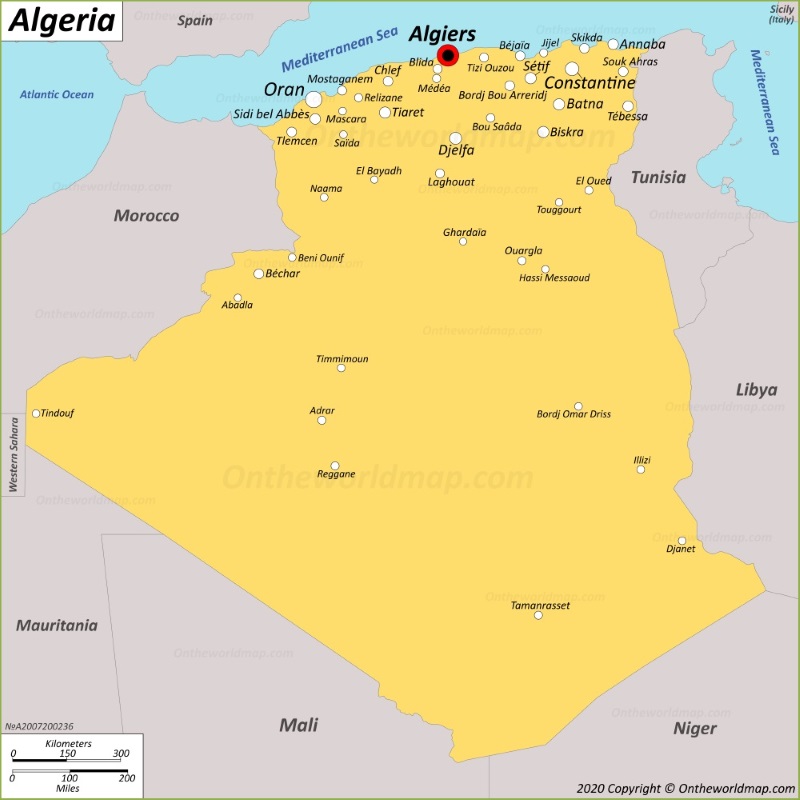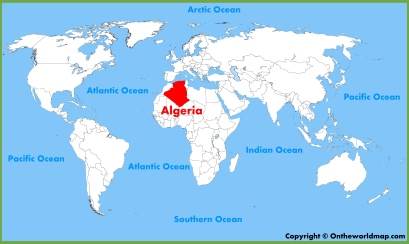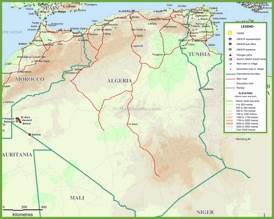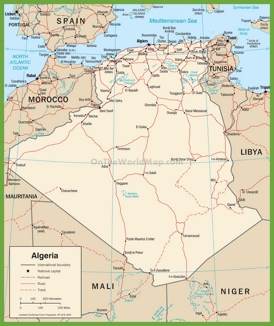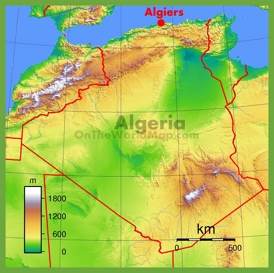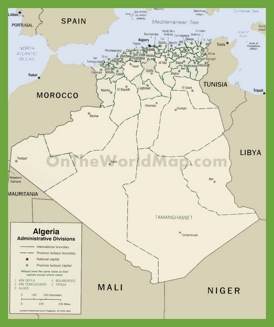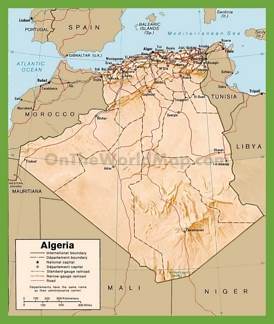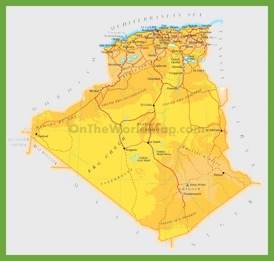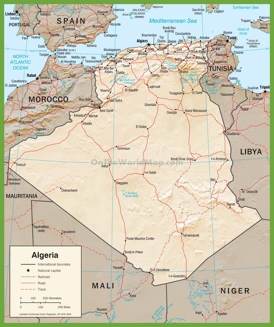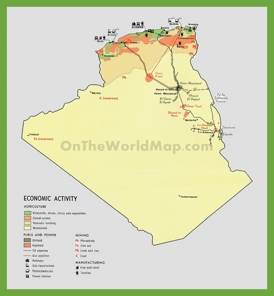Algeria Map
Description:
This map shows governmental boundaries of countries, major cities and towns in Algeria.
Size: 1000x1000px / 153 Kb
Author: Ontheworldmap.com
You may download, print or use the above map for educational, personal and non-commercial purposes. Attribution is required. For any website, blog, scientific research or e-book, you must place a hyperlink (to this page) with an attribution next to the image used.
Online Map of Algeria
About Algeria
Algeria, located in North Africa, is the largest country on the continent by area, covering about 2.38 million square kilometers. Algeria borders Tunisia and Libya to the northeast, Niger to the southeast, Mali and Mauritania to the southwest, Western Sahara to the west, and Morocco to the northwest. The country's northern border is formed by the Mediterranean Sea, which provides Algeria with a significant coastline.
Algiers, the capital and largest city, serves as the political, economic, and cultural center of the country. Located on the Mediterranean coast, Algiers plays a central role in Algeria's government and commerce. Other major cities include Oran, an important port city known for its vibrant culture, and Constantine, known for its historical significance and dramatic scenery.
Algeria's economy relies heavily on its vast hydrocarbon resources. The country is among the world's leading producers of natural gas and oil, which contribute significantly to its GDP and export earnings. Despite this wealth, Algeria faces challenges in diversifying its economy and reducing unemployment. To achieve sustainable growth, the government has made efforts to develop sectors such as agriculture, manufacturing and renewable energy.
Today, Algeria continues to overcome political and economic challenges as it strives for modernization and regional stability. The country's rich cultural heritage, natural resources and strategic location make it a key player in North Africa and the Mediterranean.
The Facts:
Capital: Algiers.
Area: 919,595 sq mi (2,381,741 sq km).
Population: ~ 45,500,000.
Largest cities: Algiers, Oran, Constantine, Batna, Djelfa, Sétif, Annaba, Sidi bel Abbès, Biskra, Tiaret, Tébessa, Chlef, Béjaïa, Bordj Bou Arreridj, Béchar, Skikda, Blida, M'Sila, Souk Ahras, El Eulma, Mostaganem, Laghouat, Tlemcen, Médéa, Tizi Ouzou, Jijel, El Oued, Ouargla, Relizane, Saïda, Bou Saâda, Guelma, Aïn Beïda, Maghnia, Mascara, Khenchela, Barika, Messaad, Aflou, Aïn Oussara.
Official language: Arabic, Berber.
Currency: Algerian dinar (DZD).
Provinces of Algeria: Adrar, Chlef, Laghouat, Oum El Bouaghi, Batna, Bouïra, Tamanrasset, Tébessa, Tlemcen, Tiaret, Tizi Ouzou, Béjaïa, Biskra, Béchar, Blida, Algiers, Djelfa, Jijel, Sétif, Saïda, Skikda, Sidi Bel Abbès, Annaba, Guelma, Constantine, Médéa, Mostaganem, El Bayadh, Illizi, Bordj Bou Arréridj, Boumerdès, El Tarf, M'Sila, Mascara, Ouargla, Oran, Tindouf, Tissemsilt, El Oued, Khenchela, Souk Ahras, Tipaza, Mila, Aïn Defla, Naâma, El M'Ghair, El Menia, Ouled Djellal, Bordj Baji Mokhtar, Aïn Témouchent, Ghardaïa, Relizane, Béni Abbès, Timimoun, Touggourt, Djanet, In Salah, In Guezzam.
Driving side: right.
Calling code: +213.
Internet TLD: .dz.
Time zone: UTC+1 (CET).
Google Map of Algeria
Geography of Algeria
Algeria, the largest country in Africa, has a diverse geography and covers an area of about 2.38 million square kilometers. Geographically, the country is divided into distinct regions, each with unique geographical characteristics.
The Tell Atlas Mountains stretch parallel to the Mediterranean coast in the north, forming a narrow strip of fertile plains and valleys. This region enjoys a Mediterranean climate characterized by mild, humid winters and hot, dry summers, favoring agriculture and densely populated centers.
Further south, the Atlas Mountains pass into the vast Sahara Desert, which covers more than 80% of Algeria. This desert region has an arid climate characterized by sharp temperature changes and minimal rainfall.
The Sahara contains significant natural resources, including oil and natural gas reserves, which play a vital role in Algeria's economy.
The central and southern parts of the country, dominated by vast sand dunes and rocky plateaus, remain sparsely populated. Despite the harsh desert conditions, some areas, such as the Ahaggar Mountains, have preserved unique ecosystems and biodiversity.
Brief History of Algeria
The history of Algeria is rich in the diversity of civilizations and cultures. The region was originally inhabited by ancient Berber tribes, followed by Phoenician and Carthaginian settlements. Roman rule created significant urban centers that contributed to the development of the region. The Arab conquest in the 7th century brought Islam, which remains the dominant religion.
Ottoman influence began in the 16th century and continued until French colonization in 1830. French rule had a significant impact on Algeria, leading to cultural and political changes. In the mid-20th century, the struggle for independence intensified, culminating in the Algerian War of Independence of 1954-1962.
In 1962, Algeria gained independence and became a sovereign State. The post-independence period was associated with state-building efforts and overcoming political and economic difficulties, which has shaped the identity and development of modern Algeria.

